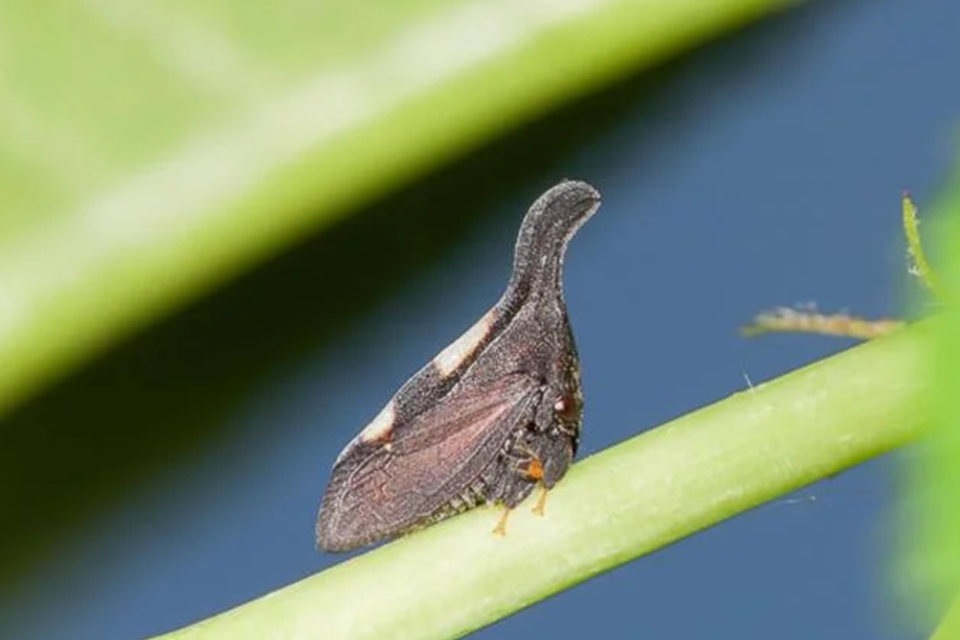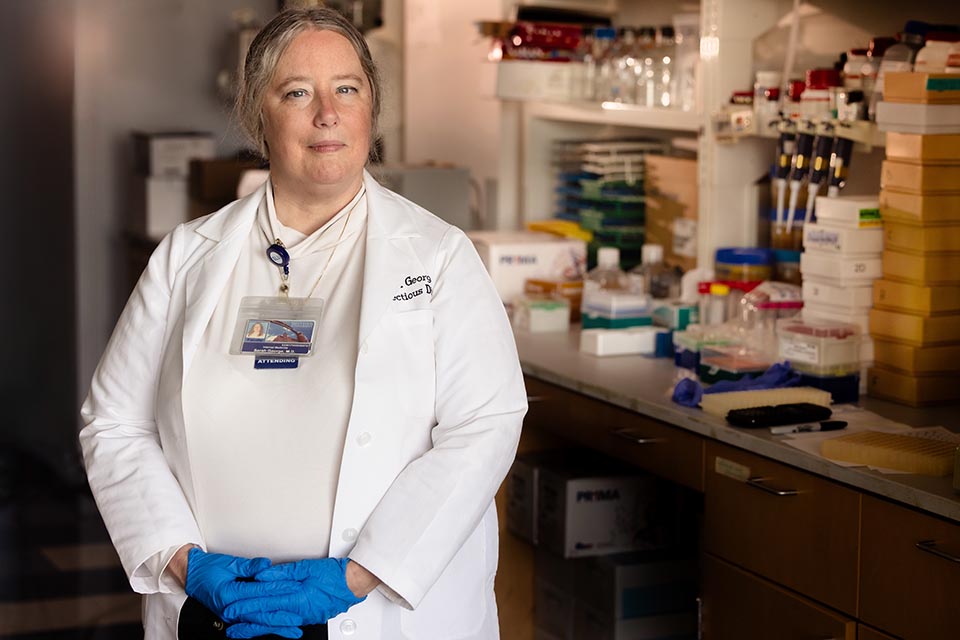Too Hot to Handle? SLU Researchers Examine How Temperature Affects Treehoppers
Kasey Fowler-Finn, Ph.D., an associate professor of biology at Saint Louis University, and Noah Leith, a recent Ph.D. graduate from Saint Louis University, published a paper in Functional Ecology that examined the thermoregulatory tendencies in plant-living insects. They determined that, while this thermoregulation improved survival in the species, it did not increase reproduction, pointing to a long-term concern for the insect.

In their study, the team of SLU researchers found that treehoppers only self-regulated their body temperature when absolutely necessary, and did not engage in such behavior for reproduction. Photo courtesy of Missouri Department of Conservation.
“When you look at responses to climate change, the best predictor of responses to climate change is how well you reproduce,” Fowler-Finn said. “So it makes sense that with that thermoregulation, a species should also evolve to maximize reproduction as well as survival. In this paper, Noah was testing exactly that. We asked: Are these treehoppers thermoregulating in order to maximize reproduction or are they only doing so to maximize survival? We found that they're avoiding lethal temperatures and that's about it.”
Thermoregulation is the ability of an organism to maintain its body temperature within a certain livable range, even if that range is only a subset of what’s available in the surrounding environment. Some animals can internally thermoregulate, while others can only do so externally. Plant-living insects fall into the latter category, requiring behavioral thermoregulation. So, Leith, Fowler-Finn and their team set out to investigate how that behavior affected reproductive rates of treehopper insects.
Treehoppers have a wide range of livable temperatures, but a much smaller range of temperatures ideal for reproduction. In their study, Leith, Fowler-Finn and their colleagues examined these insects in nature to determine how they engaged in thermoregulatory practices, and also conducted laboratory thermal preference experiences.
What the team found was that treehoppers only self-regulated their body temperature when absolutely necessary. These insects find themselves within a range of 18 degrees to 45 degrees celsius, but started to engage in thermoregulatory behavior once the temperature reached 36 degrees celsius. That benchmark was significant, as temperatures between locations on a single plant can differ an incredible 19 degrees celsius at any given moment. The difference between a treehopper choosing to thermoregulate or not could be as simple as if it is in the shade or in the sun.
“We went into it thinking that they would seek out these microclimates that are really good for mating because it's super important for organisms to mate and produce,” Leith said. “It was surprising and interesting to us that they aren't thermoregulating at all to enhance mating activity; they're mainly only thermoregulating solely to survive, only when it's super stressful and it might cause them to die.”
“These findings are important for a few different reasons,” Fowler-Finn added. “One of the most interesting and significant findings was that there's extreme variation in temperature on a single plant that these animals live on. A single plant can vary nearly 20 degrees celsius. That’s a huge number that’s almost hard for us to comprehend, and because nearly half of all insect species are plant-living, they could be experiencing those huge variations in temperature. The other significant finding was that we found that the insects are not actually directly choosing microclimates. They're conforming to the temperatures that are available, except for when it's really hot. When it reaches that point, they jump off the plant in hopes that they'll find a better spot to land on. So we know that they're not choosing microclimates and are basically stuck with the temperatures that they find themselves and only move when forced to.”
The study also found that while treehoppers engaged in this thermoregulation for survival, the insect did not engage in such behavior for reproduction. Reproductive behavior affects overall population viability, so a lack of thermoregulation to maximize reproduction could lead to lower populations of treehoppers.
“We found that treehoppers are only thermoregulating when they're beyond their lethal limit, which was 36 degrees celsius,” Fowler-Finn said. “With how variable the climate is, the fact that they're not able to thermoregulate to maximize reproduction is a major discovery. Climate change is restricting the temperatures that are good for mating to occur, which means they're going to have restricted time periods for mating as well. This could cause a shift in their mating patterns, and reproductive rates are really important for population persistence. That’s what we’re going to examine next, figuring out impacts of temperature on reproductive output and modeling and projecting responses to climate change. The impact of declining populations extends beyond this species. A lot of the bird declines we've been experiencing have been tied into insect declines."
When insect populations start to crash, we're going to have a hard time with all sorts of other animal populations that rely on insects for food."
Kasey Fowler-Finn, Ph.D., associate professor of biology at Saint Louis University
A declining population of treehoppers, and other insects facing increased temperatures due to climate change, could create a butterfly effect throughout the environment. Insects serve as important prey for a multitude of predators, and that lack of food could affect those populations as well. As climate change continues to impact organisms globally, increasing temperatures decreases the range of temperatures that is ideal for reproduction, leading to population declines. All organisms are linked together as well, and the team believes more research is necessary to understand how temperature affects these behaviors and what those ramifications may be.
“I think there's a lot more work that needs to be done to link these findings with conservation efforts and policy changes,” Leith said. “We need to have a more intricate understanding of the organisms we’re trying to protect, and understand how their behaviors are tied to temperature. By understanding their really unique behaviors, we can then hopefully learn how they’ll react to climate change. Understanding those behaviors, rather than looking at broad survival rates, could be the key for population persistence.”
Latest Newslink
- A Camp Friendship that Stirred Up Lifelong BondsIn the summer of 2005, Mary Kate Keenoy (Chaifetz Grad '22) and Genevieve Willman met at SLU's Gardens to Tables culinary camp. What started as a shared interest in cooking grew into a lasting friendship that has endured for two decades.
- Bruce Bacon, M.D.: 1949-2025Bruce Bacon, M.D., professor emeritus of internal medicine, died Sunday, July 6, 2025. He was 75. Bacon was known globally for his expertise in all aspects of clinical hepatology, specifically hemochromatosis, viral hepatitis, chronic liver disease / general hepatology, and liver transplant. Bacon was also a member of the research team that discovered the gene for hemochromatosis, HFE, in 1996.
- SLU Launches William L. Clay, Sr. Institute of Civic Engagement and Economic JusticeThe Clay Institute will provide immersive learning experiences and hands-on training that address the social and economic challenges facing the St. Louis region and the nation. Institute programming will be available to all students with an interest in civic engagement and democratic participation.
- SLU Research Explores Depression's Ripple Effect on DiabetesA study conducted by researchers at Saint Louis University found that patients with depression were more likely to have uncontrolled diabetes over time and that depression contributes to a heightened economic burden to diabetes management.
- SLU/YouGov Poll: Statewide Cell Phone Ban for Missouri Schools Popular with VotersGovernor Mike Kehoe has signed Senate Bill 68 into law, enacting a statewide ban on the use of personal electronic devices, including cell phones, tablets, and smartwatches, throughout the school day in Missouri public and public charter schools.
- SLU Vaccine Center Will Enroll Healthy Volunteers in Yellow Fever Vaccine Clinical TrialSaint Louis University's Center for Vaccine Development will enroll up to 70 adult volunteers in a clinical trial to study the safety elicited by a new investigational vaccine for yellow fever, a potentially deadly disease that is spread by mosquitoes. The research is funded by Sanofi Pasteur.













